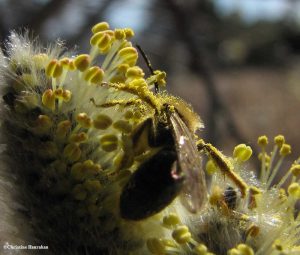by Sandy Garland

Andrena dunningi collecting pollen from willow flowers. Photographed by Christine Hanrahan on 15 April 2009 at the Fletcher Wildlife Garden.
Although Andrenid species are common, you may not have noticed these little gold bees. The hibernating adults emerge from underground tunnels in spring, before most plants get started. After mating, the females look for a place to make a nest, pollinate early-blooming trees, stock their burrows (with both nectar and pollen) and lay eggs. By June, most are gone, although a few species in this family live longer into the summer. Andrenids are solitary, but a number of them will make burrows close together when they find a good spot.
According to Christine Hanrahan, “Andrenids prefer areas of bare soil with scattered vegetation, such as sparsely growing grass, and show a distinct preference for the tops of slopes. Their burrows are about 4-6 inches in length, as best as I can determine, so we don’t want to plant species with deep spreading roots that might prevent them from burrowing. Reading I have done indicates that they will nest under exposed tree roots, but they are much happier with bare soil” (see Andrenid bees at the FWG).
Welcoming Andrenids to your garden
Many of our native bees make tunnels and underground nests for their offspring. If you notice Andrenids (or other digging bees) or find tiny holes in your garden soil, please welcome them. Their nests don’t cause damage, and these docile bees rarely sting.
Females will make many trips to your garden bed as they dig their tunnels, then stock them with balls of pollen and lay eggs.
CAUTION: Certain gardening practices are detrimental to ground-nesting bees: tilling the soil can destroy their nests, and mulching will make the ground surface unattractive for bees or disrupt any nesting that has already started.
At the Fletcher Wildlife Garden (FWG), we’ve found Andrenids nesting in bare soil on the north slope of our Amphibian Pond, very close to a willow tree that blooms about the same time as the bees emerge – what a coincidence! They have also been seen in our Old Woodlot, where many bloodroots bloom, also early in spring. We’ve identified 7 species in this family: Andrena cressonii, Andrena dunningi, Andrena miserabilis, Andrena nasonii, Andrena rufosignata, Andrena vicina, and the non-native Andrena wilkella.
Please feel free to share your observations and photos of these and other bees that visit your garden.
Further information
- Wikipedia: Andrena (includes a great video of Andrena vaga digging a tunnel)
- Discover Life: Andrena species
- BugGuide: Genus Andrena
- The Tickle Bees of Sabin Elementary | video: Tickle bees
